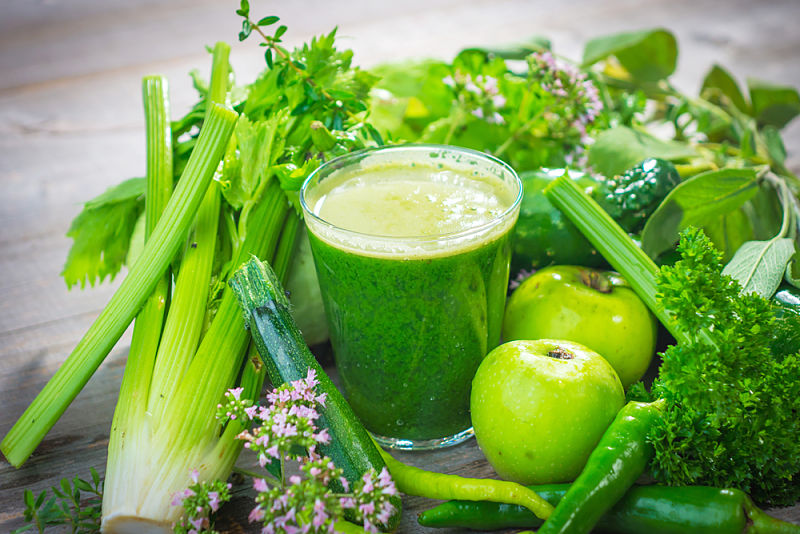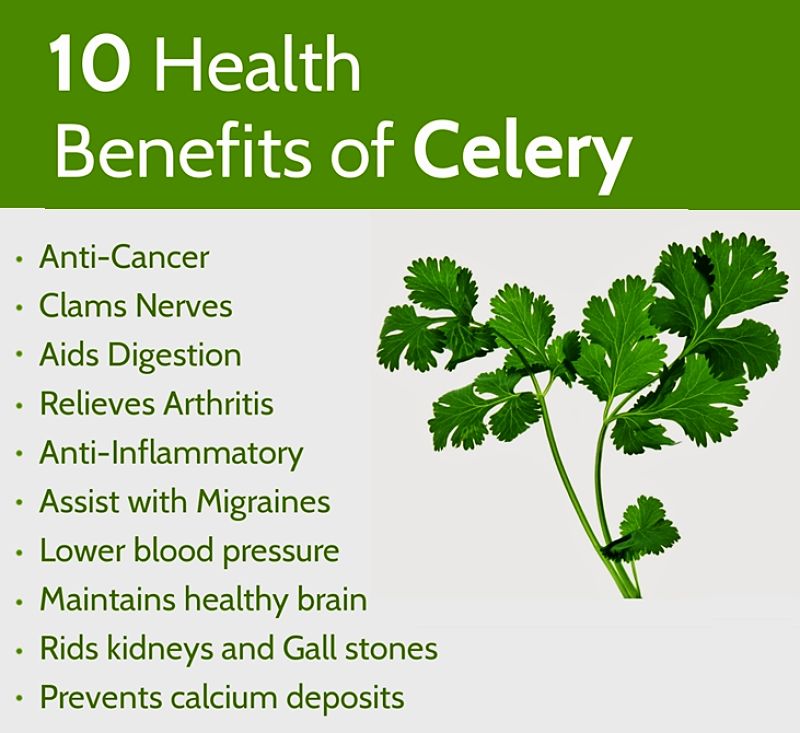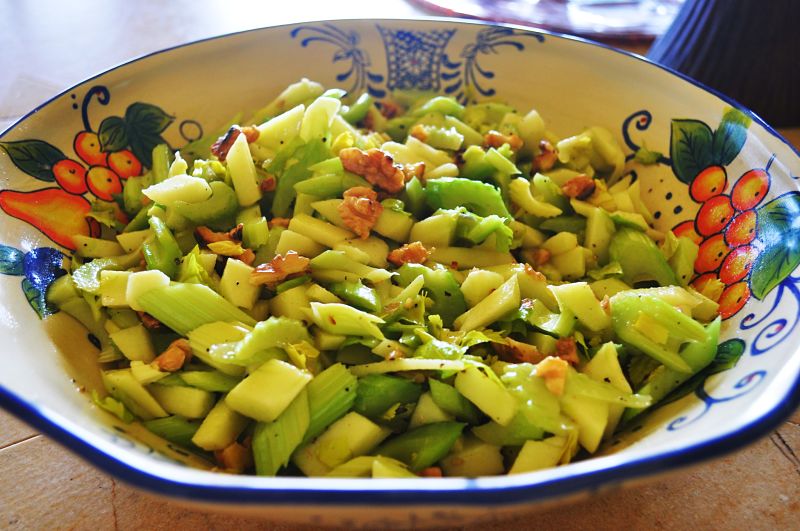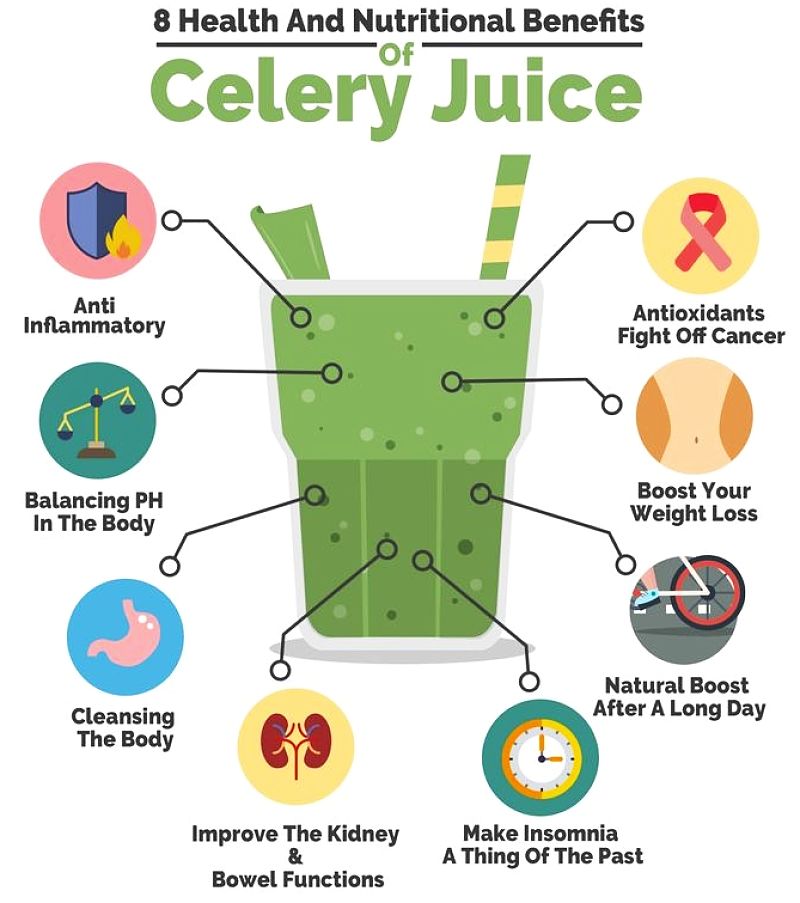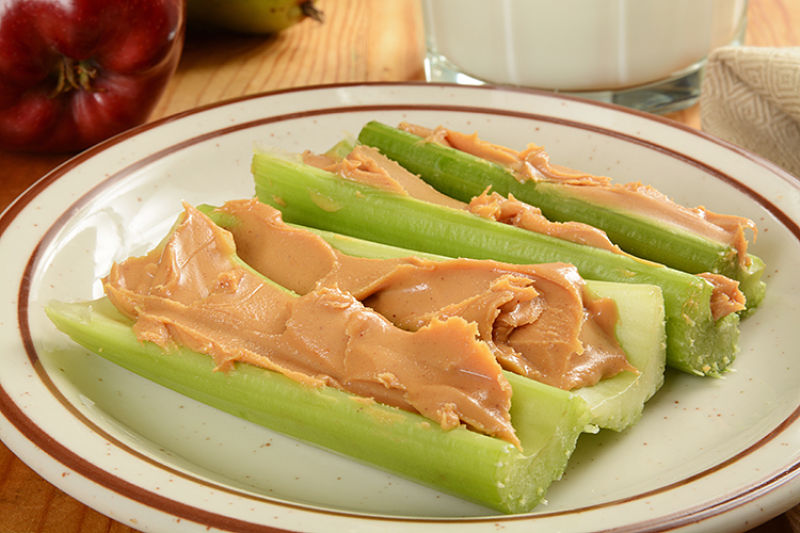Celery Health Benefits, Nutritional Values and Culinary Uses
Celery is a crisp, green vegetable and herb renowned for its low calories and the fabulous array of health benefits and nutritional values. Celery is a bulky food rich in fiber that fills you up. Usually the long stems and stalks of celery are eaten, but the leaves and main root can also be consumed as well.
Celery has only 16 Calories for each 100 g, and it is rich in fiber and minerals. It is regarded by many as a classic example of a negative calorie food, that is a food that may require more calories to munch and digest, that it yields as food value.
Although 'negative calorie foods' are known to be a myth, celery stalks feature prominently in many diets and weight loss programs because celery has a very low calorie density (calories per volume).
Celery is an ideal snack food for controlling appetite while trying to lose weight.
Celery (Apium graveolensplant) belongs to the family of Apiaceae and is related to parsnip, parsley, fennel, dill, cumin, coriander/cilantro, carrot, caraway and anise.
This article summarizes the health benefits, nutritional facts for celery in relation to similar plants cabbage, carrots, chard, and iceberg lettuce. It also summarizes the culinary uses for celery.
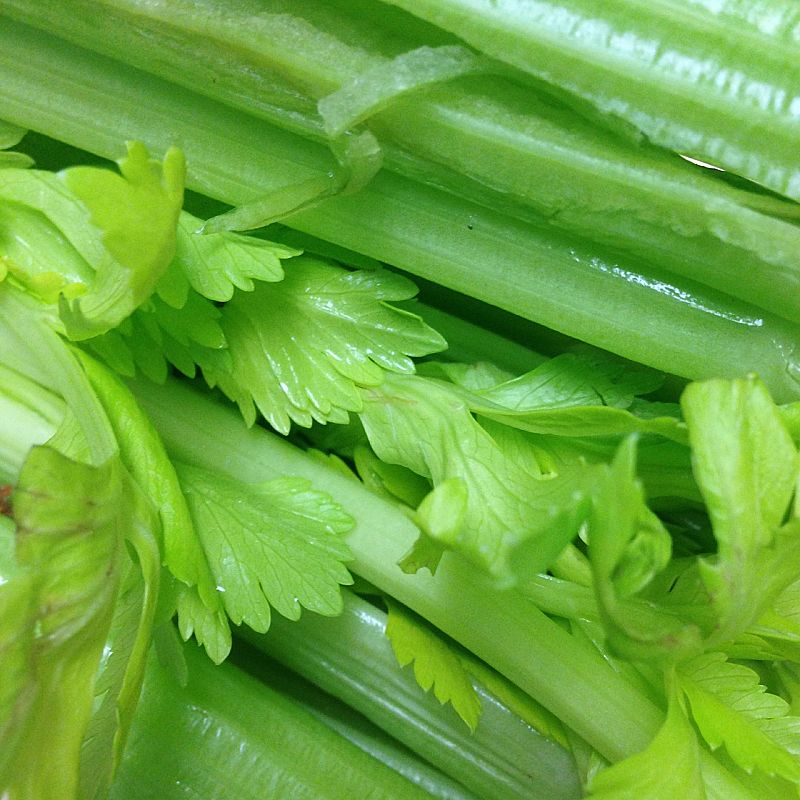
Health Benefits of Celery
Celery Nutritional Facts (100 g; raw)
|
Serving 100g
|
Nutrient Value
|
% recom. Daily Allowance
|
|---|---|---|
|
Energy
|
16 Cal
|
<1%
|
|
Carbohydrates
|
3 g
|
5.5%
|
|
Protein
|
0.69 g
|
6.0%
|
|
Total Fat
|
0.28 g
|
4.5%
|
|
Cholesterol
|
0 mg
|
0.0%
|
|
Dietary Fiber
|
1.6 g
|
5.5%
|
|
Vitamins
|
|
|
|
Folates
|
36 mcg
|
9.0%
|
|
Niacin
|
0.32 mg
|
2.0%
|
|
Pantothenic acid
|
0.25 mg
|
5.0%
|
|
Pyridoxine
|
0.07 mg
|
6.0%
|
|
Riboflavin
|
0.57 mg
|
4.0%
|
|
Thiamin
|
0.022 mg
|
2.0%
|
|
Vitamin A
|
449 IU
|
15.0%
|
|
Vitamin C
|
3.1 mg
|
5.0%
|
|
Vitamin K
|
29.3 mcg
|
24.0%
|
|
Vitamin K
|
|
|
|
Electrolytes
|
|
|
|
Sodium
|
80 mg
|
5.0%
|
|
Potassium
|
260 mg
|
5.5%
|
|
Minerals
|
|
|
|
Calcium
|
40 mg
|
4.0%
|
|
Copper
|
0.35 mg
|
4.0%
|
|
Iron
|
0.20 mg
|
2.5%
|
|
Magnesium
|
11 mg
|
3.0%
|
|
Manganese
|
0.10 mg
|
4.5%
|
|
Phosphorus
|
24 mg
|
3.0%
|
|
Zinc
|
0.13 mg
|
1.0%
|
|
Phyto-nutrients
|
|
|
|
Carotene-beta
|
270 mcg
|
--
|
|
Crypto-xanthin-beta
|
0 mcg
|
--
|
|
Lutein-zeaxanthin
|
283 mcg
|
--
|
Health Benefits of Celery
The two tables provide summaries of the nutrients in raw celery:
- Celery stems and leaves are a low calorie food. They are rich sources of flavonoid antioxidants such as zeaxanthin, beta-carotene and lutein, which protect the bidy from anti-oxidants and help maintain the immune system.
- Celery is a rich source of key vitamins such as folic acid (providing 9% of recommended daily allowance), riboflavin (4%), niacin (2%), Vitamin A (15%), Vitamin K (24%) and vitamin-C (5%), which are essential for supporting the metabolism and maintaining healthy skin.
- Celery is also an excellent source of minerals like sodium, potassium, calcium, magnesium and manganese.
- Celery provides an excellent source of many of the B Group vitamins such as vitamins B1, B2 and B6.
- Celery juice is known to aid digestion, lower cholesterol and is an excellent an appetite suppressant. Celery juice is known to have anti-inflammatory properties and to aid detoxification of the body.
- Celery contains phytochemicals known as phthalides, which research has shown can help reduce the levels of hormones that cause stress. These chemicals also help to relax the muscle walls in arteries and stimulate the circulation. Celery has been traditionally used in Chinese medicine to help control problems with high blood pressure.
Celery Nutrient Comparisons with Other Green Vegetables
The table below compares the nutrients in celery (100g) with those in 100g of similar vegetables: cabbage, carrots, Swiss chard, and iceberg lettuce.
The main features for celery are:
- Very low calories (only 16 Calories per 100g) and very low carbohydrate content
- Relatively high levels of Vitamin B6, folate, riboflavin, Vitamin E and Vitamin K.
- Celery has a high content of sodium but this is offset by high levels of potassium. Studies ave shown that it is the sodium to potassium ratio that is important rather than the sodium level itself.
- In terms of minerals the key benefits of celery are: Phosphorus, Magnesium, Manganese, and copper.
- Celery has very low levels of fat and no cholesterol.
- Celery is also a good source of dietary fiber.
- Protein levels are low but higher than for the other vegetables.
Comparison of Nutrients in Celery with Other Similar Vegetables
|
Serving 100g (raw)
|
Celery
|
Cabbage, savoy
|
Carrots
|
Chard, swiss
|
Lettuce, iceberg
|
|---|---|---|---|---|---|
|
Macronutrients
|
|
|
|
|
|
|
Calories (kcal)
|
16
|
27
|
35
|
19
|
14
|
|
Protein (g)
|
0.69
|
2.00
|
0.64
|
1.81
|
0.89
|
|
Total Fat (g)
|
0.18
|
0.10
|
0.13
|
0.19
|
0.14
|
|
Total Carbohydrates (g)
|
2.98
|
6.10
|
8.24
|
3.75
|
2.96
|
|
Dietary Fiber (g)
|
1.63
|
3.14
|
2.88
|
1.67
|
1.23
|
|
Sugar (g)
|
1.83
|
2.27
|
4.76
|
1.11
|
1.96
|
|
Vitamins
|
|
|
|
|
|
|
Vitamin C (mg)
|
3.13
|
31.00
|
2.63
|
30.00
|
2.81
|
|
Thiamin (mg)
|
0.02
|
0.07
|
0.03
|
0.04
|
0.04
|
|
Riboflavin (mg)
|
0.06
|
0.03
|
0.04
|
0.09
|
0.02
|
|
Niacin (mg)
|
0.32
|
0.30
|
0.56
|
0.40
|
0.12
|
|
Pantothenic Acid (mg)
|
0.25
|
0.19
|
0.40
|
0.17
|
0.09
|
|
Vitamin B6 (mg)
|
0.07
|
0.19
|
0.11
|
0.10
|
0.04
|
|
Folate (mcg)
|
36.25
|
80.00
|
27.50
|
13.89
|
29.82
|
|
Vitamin B12 (mcg)
|
0.00
|
0.00
|
0.00
|
0.00
|
0.00
|
|
Vitamin A (IU)
|
448
|
1000
|
13790
|
6116
|
501
|
|
Vitamin E (mg)
|
0.28
|
0.17
|
|
1.89
|
0.18
|
|
Vitamin K (mcg)
|
29.25
|
68.86
|
9.38
|
830.00
|
24.04
|
|
Minerals
|
|
|
|
|
|
|
Calcium (mg)
|
40.00
|
34.29
|
32.50
|
50.00
|
17.54
|
|
Iron (mg)
|
0.20
|
0.40
|
0.89
|
1.81
|
0.40
|
|
Magnesium (mg)
|
11.25
|
28.57
|
10.00
|
80.56
|
7.02
|
|
Phosphorus (mg)
|
23.75
|
41.43
|
27.50
|
47.22
|
19.30
|
|
Potassium (mg)
|
260.00
|
230.00
|
237.50
|
377.78
|
140.35
|
|
Sodium (mg)
|
80.00
|
28.57
|
77.50
|
213.89
|
10.53
|
|
Zinc (mg)
|
0.13
|
0.27
|
0.18
|
0.36
|
0.16
|
|
Copper (mg)
|
0.04
|
0.06
|
0.10
|
0.18
|
0.02
|
|
Manganese (mg)
|
0.10
|
0.18
|
0.15
|
0.37
|
0.12
|
|
Selenium (mcg)
|
0.38
|
0.86
|
0.88
|
0.83
|
0.18
|
|
Fatty Acids
|
|
|
|
|
|
|
Saturated Fat (g)
|
0.04
|
0.01
|
0.02
|
0.03
|
0.02
|
|
Monounsaturated Fat (g)
|
0.03
|
0.01
|
0.01
|
0.04
|
0.01
|
|
Polyunsaturated Fat (g)
|
0.08
|
0.05
|
0.07
|
0.07
|
0.07
|
Preparation and Culinary Uses of Celery
Larger, more mature celery stalks have long 'strings', which are unpleasant to many people and should be removed if the celery is to be eaten as stalks rather than being finely chopped. These strings can be easily removed by snapping the bottom end of the celery. This will display the strings which can be pulled out one at a time. Thinly slicing celery cross-wise also chops the strings into small pieces eliminating the problem.
After you buy fresh celery it can be easily prepared by wash the stems and leaves in cold water. Thinner and younger stems are best for salads unless you like the extra crunch and stronger flavor of the older stems.
Some of the many uses for celery are:
- Celery and cashew stir-fry
- Celery soup
- Finely chopped celery can be added to pasta sauce
- Celery sticks can be used with dips for entrees
- Chopped celery stems and leaves can be added to stir-fry dishes.
- Chopped an sliced celery stalks can be added to salads and stews
- Celery seeds are an interesting spice that can be added to soups and pickle recipes and to other dishes.
Celery Recipe Ideas
- Braised Hearts of Celery Vinaigrette
- Curried Waldorf Salad
- Celery and Potato Soup
- Wild Rice Salad With Celery and Walnuts
- Celery, Walnut, and Parmesan Salad
- Chicken with Cinnamon, Celery and Basil
- Beef, Celery and Sesame Stir-fry
- Spicy Celery Dry Curry
- Cream of Celery Soup
- Egg, Celery and Salad Sandwich
- Chunky Celery Soup
- Bulgur, Celery and Pomegranate Salad
- Christmas Lima Bean and Celery Stew
- Parmesan Celery Salad

